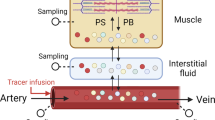Summary
Urea and plasma protein differ in natural15N abundance up to 10‰ The origin of this difference is the branched nitrogen metabolism in the liver. One main branch is the protein synthesis pathway, the other the urea synthesis pathway. By this branching15N of precursor amino acids is depleted in urea while it is enriched in protein. With the15N abundance of precursor amino acids, which may be taken from jejunum tissue, utilization of amino acids in liver metabolism can be calculated from isotope discrimination in either pathway.
This was investigated by feeding different proteins to rats. When feeding high quality protein (whey protein) utilization of amino acids in liver metabolism at requirement intake was better than at zero protein intake (>85% vs. 70%). From this we conclude that the pattern of amino acids available from the metabolic pool at zero protein intake is characterized by an imbalance. This endogenous imbalance can be complemented by exogenous dietary amino acids so that nitrogen excretion may even be smaller than the so-called „obligatory“ losses of intakes not exceeding requirement. Thus, the quality of dietary protein is reflected not only by N balance. It also may be quantified by analysis of isotope discrimination in nitrogen metabolism of the liver. In addition, the quality of amino acid pattern available from the metabolic pool is indicated by this method.
Zusammenfassung
Zwischen Harnstoff und Plasmaprotein besteht ein natürlicher Unterschied der15N-Häufigkeit von bis zu 10‰. Die Ursache hierfür ist der verzweigte Stickstoff-Metabolismus in der Leber. Ein Hauptzweig ist die Proteinsynthese, im zweiten Hauptzweig wird der Aminostickstoff zur Harnstoff-Synthese verwendet.15N der Vorläuferaminosäuren wird hierbei, abhängig von den Umsatzraten, im Harnstoff abgereichert und im Protein angereichert. Unter Hinzuziehung der15N-Häufigkeit der Vorläuferaminosäuren, die sich aus Jejunum-Gewebe bestimmen läßt, kann aus der Isotopendiskriminierung in den beiden Stoffwechselzweigen die Utilisierung der Aminosäuren in der Leber berechnet werden.
Dies wurde an Ratten nach Fütterung mit verschiedenen Proteinen untersucht. Es zeigte sich, daß bei Verzehr von hochwertigen Proteinen die Utilisierung der Aminosäuren im Stoffwechsel der Leber bei bedarfsgerechter Fütterung besser war (Molkenprotein: >85%) als bei Proteinkarenz (70%). Das bedeutet, daß das Muster der aus dem metabolischen Pool verfügbaren Aminosäuren bei Proteinkarenz eine Imbalanz aufweist. Durch exogene Aminosäuren aus der Nahrung kann diese endogene Imbalanz offenbar komplementierend ausgeglichen werden, so daß die Stickstoffausscheidung bei nicht bedarfsüberschreitendem Verzehr sogar unter den Werten der sogenannten „obligaten“ oxidativen Verluste liegen kann. Die Qualität von Nahrungsproteinen spiegelt sich also nicht nur in den N-Bilanzen wider. Sie wird auch durch Bestimmung der Utilisierung der Aminosäuren im Stoffwechsel der Leber mit Hilfe der Analyse der Isotopendiskriminierung quantifizierbar. Zusätzlich wird mit dieser Methode eine Aussage über die Qualität des Musters der metabolisch verfügbaren Aminosäuren gewonnen.
Similar content being viewed by others
References
Wutzke KD, Heine W, Plath C, Müller M, Uhlemann M (1992) Whole body protein parameters in premature infants: A comparison of different15N tracer substances and different methods. Pediatric Research 31:95–101
Sick H, Roos N, Trugo N (1990) Analysis of isotope ratio disproportionation for evaluation of metabolic rates and dietary requirements. Proc Nutr Soc 49:85A
Sick H (1991) Evidence for basic imbalance of the endogenous amino acid pattern. Proceedings The 6th International Symposium on Protein Metabolism and Nutrition, Herning, Denmark, 9 – 14 June 1991. Eggum B, Boisen S, Børsting Chr, Danfær A, Hvelplund T (eds) EAAP-publication no 59, National Institute of Animal Science, Research Centre Foulum, Dänemark, Vol. 2, pp 136–138
Sick H, Roos N, Trugo N (1994) Diskriminierung der Stickstoff-Isotope im Leber-Metabolismus nach Verzehr von unterschiedlichen Nahrungsproteinen. Isotopes Environ Health Stud 30:111–121
Paneth P (1992) How to measure heavy atom isotope effects: General principles. In: Isotopes in Organic Chemistry. Buncel E, Saunders Jr WH (eds.) Vol. 8, Heavy Atom Isotope Effects, pp 41–68
Macko SA, Fogel Estep ML, Engel MH, Hare PE (1986) Kinetic fractionation of stable nitrogen isotopes during amino acid transamination. Geochim Cosmochim Acta 50:2143–2146
Schimerlik MI, Rife JE, Cleland WW (1975) Equilibrium perturbation by isotope substitution. Biochemistry 14:5347–5354
Gaebler OH, Trieste GV, Vukmirowich R (1966) Isotope effects in metabolism of14N and15N from unlabeled dietary proteins. Can J Biochem 44:1249–1257
Handley LL., Raven JA (1992) The use of natural abundance of nitrogen isotopes in plant physiology and ecology. Plant, Cell & Environment 15:965–985
Young VR, Pellet PL (1988) How to evaluate dietary proteins. In: Milk Proteins — Nutritional, Clinical, Functional and Technological Aspects Barth CA, Schlimme E (eds.) Steinkopf Verlag Darmstadt, Springer-Verlag New York, pp 5–36
Eggum BO (1973) A study of certain factors unfluencing protein utilization in rats and pigs. 406 Beretning fra forsøgslaboratoriet, Landhusholdnings-selskabets forlag, København, pp 174
Schreurs VVAM, Koopmanschap RE, Boekholt HA (1977) Short term dynamics in protein and amino acid metabolism. Z Ernährungswiss 36:336–339
Author information
Authors and Affiliations
Rights and permissions
About this article
Cite this article
Sick, H., Roos, N., Saggau, E. et al. Amino acid utilization and isotope discrimination of amino nitrogen in nitrogen metabolism of rat liverin vivo . Z Ernährungswiss 36, 340–346 (1997). https://doi.org/10.1007/BF01617819
Published:
Issue Date:
DOI: https://doi.org/10.1007/BF01617819




